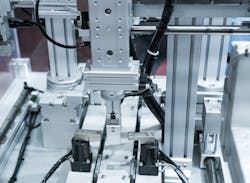Various forms of automation are entering the industries served by fluid power, bringing with it new technologies and capabilities — as well as new design challenges. But how exactly will hydraulics and pneumatics be impacted by automation?
A greater integration of electronics, particularly sensors, is a key change taking place. While not a new phenomenon, technology improvements and increased interest in efficiency and accuracy — both of which can benefit automation — have helped to grow the pairing of electronics with fluid power components and systems. And with the rising use of electronics has come the ability to increase the connectivity and communication between systems, which is again beneficial for the implementation of automation.
Because hydraulic and pneumatic components are becoming more electronic and software controlled, autonomy can be added explained Peter Bleday, Head of Autonomy at Danfoss Power Solutions, in an interview with Power & Motion. That digital control is a key interface between the automation system and the parts of the machine which do the work — which are typically powered by hydraulics and pneumatics.
READ MORE: Sensors and Software Bring Performance Benefits to Motion Control Systems
Will New Technologies Take Over the Market?
As with electrification, there is a question whether or not hydraulic and pneumatic components will be replaced by electric alternatives to meet the requirements of automation systems. From conversations the Power & Motion team has had, yes, there will be instances in which electric motion control devices are the preferred option for automation systems.
One company explained during a conversation at Automate in May 2023 it is encouraging use of electric over pneumatic because of the accuracy which can be achieved. It was explained that with electric options, there is the ability to integrate encoders which is not as feasible with pneumatics; encoders can be integrated, but not all values that an OEM may want measured can be whereas electric options enable all values to be measured.
READ MORE: Automate 2023 Demonstrates Excitement, Need for Industry Education on Automation
However, this does not mean hydraulics and pneumatics will be completely replaced. There are still many applications in which they will be used, such as mobile machinery like construction equipment.
There will also be instances in which a hybrid approach pairing fluid power and electric motion control devices is beneficial. In the article "Optimizing Linear Motion Solutions Using Hybrid Automation Systems," author Linda Schwartzen explains that electropneumatic hybrid automation systems, for instance, can benefit those applications in which there may be space limitations or robust operation is required and thus a combination of electric and pneumatic is the best fit.
The needs and capabilities of automation, and its impacts on fluid power systems, will continue to evolve as the technology develops further to improve safety and efficiency, as well as overcome labor challenges in various industries. While design challenges will certainly exist, there are many opportunities automation will bring to hydraulics and pneumatics including performance enhancements and new application possibilities.
We want to hear from you!
How are you seeing the implementation of automation impacting hydraulics and pneumatics? What technologies are you seeing entering the market to enable the creation of automated systems?
Let us know! Take our survey to provide your input on this growing industry trend.
Or reach out directly via email [email protected] or on social media.
Twitter: @TechnlgyEditor or @PowerMotionTech
LinkedIn: @PowerMotionTech



